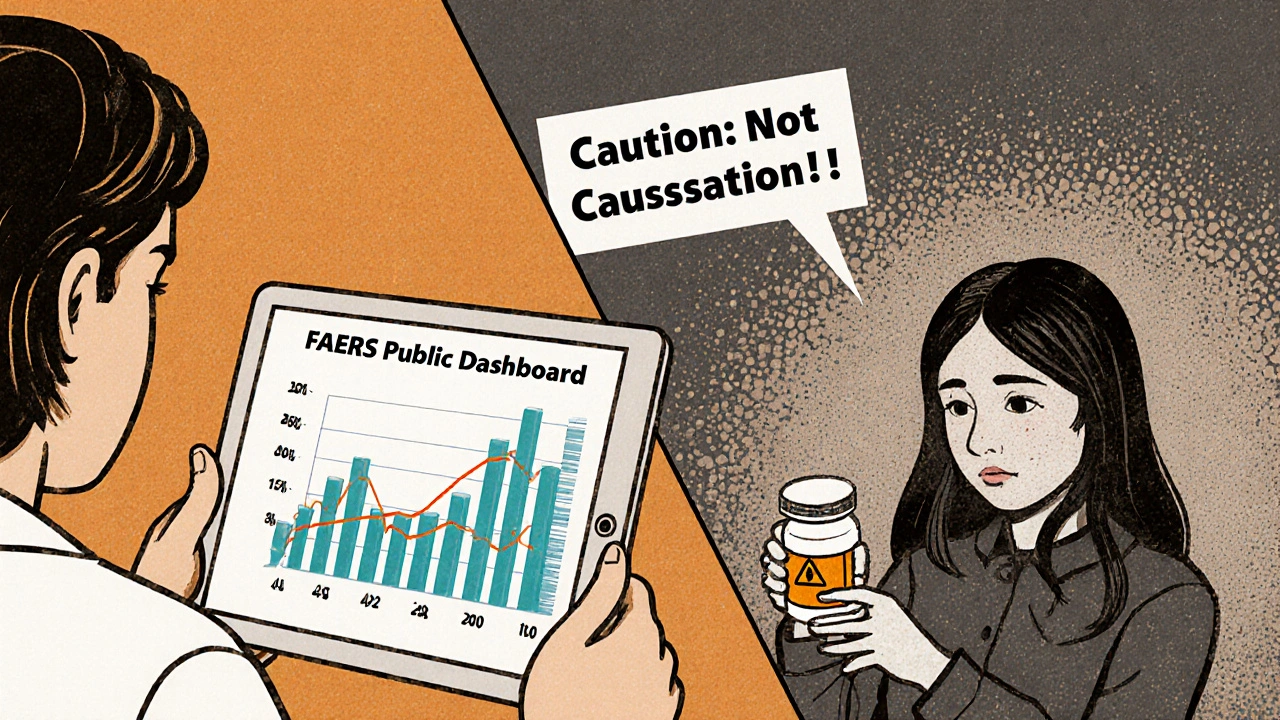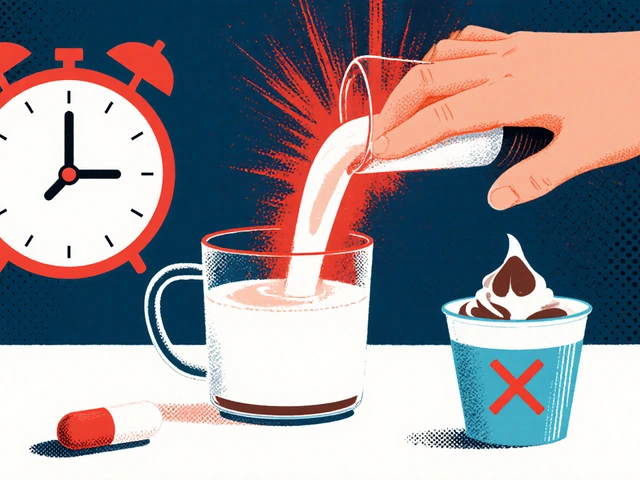
FAERS Side Effect Report Calculator
FAERS data shows reports of side effects, but it doesn't tell you actual risk because we don't know how many people took the drug. This tool helps you estimate incidence rates while understanding the limitations of the data.
Important Limitations: FAERS data shows reports, not confirmed causation. Many factors affect reporting rates (e.g., drug popularity, awareness of side effects). This tool provides a rough estimate based on incomplete data.
When you’re trying to find out what side effects might be linked to a medication, the FDA’s FAERS database is one of the most powerful tools available. But if you’ve ever tried searching it, you know it’s not as simple as typing in a drug name and getting clear answers. FAERS isn’t a list of confirmed dangers-it’s a raw collection of reports, some verified, many not. And without knowing how to read between the lines, you could easily misinterpret what you see.
What FAERS Actually Shows (And What It Doesn’t)
FAERS stands for the FDA Adverse Event Reporting System. It’s a public database that collects reports of side effects, medication errors, and product issues linked to drugs and biologics. Since August 2024, the FDA has updated it in real time-meaning reports show up within days, not months. That’s a big upgrade from the old quarterly system, which could delay safety signals by up to 90 days.
But here’s the catch: FAERS doesn’t prove a drug caused a side effect. It only shows that someone reported a reaction after taking it. Think of it like a noise filter. A sudden spike in reports about dizziness after taking Drug X doesn’t mean Drug X causes dizziness. It could mean more people are using it, doctors are asking patients about dizziness more often, or a news story made people more likely to report it.
The FDA uses FAERS to spot patterns-not to confirm causes. If a pattern emerges across hundreds of reports, scientists dig deeper with controlled studies. That’s how warnings get added to labels, or in rare cases, drugs get pulled from the market. But if you’re using FAERS to decide whether to take a medication, you need to understand its limits.
How to Search FAERS Correctly
The easiest way to search is through the FAERS Public Dashboard. Go to the FDA’s website, find the dashboard, and click the blue search bar at the top. Type in the generic name of the drug-like metformin, not Glucophage. Brand names vary by country and can confuse the search.
After you search, you’ll see a bar chart showing reports by year. To see the actual side effects, look to the right of the chart. There’s a drop-down menu labeled “Cases by Reaction.” Click it. Now you’ll get a list of symptoms reported, ranked by frequency. The top ones are usually the most common, but again-frequency doesn’t equal causation.
Here’s a practical tip: if the drug you’re looking for has multiple names, try them all. For example, lisinopril is also sold as Zestril and Prinivil. The dashboard lets you search up to five drug names at once. If you’re comparing two drugs, enter them together to see how their side effect profiles differ.
Use the filters. You can narrow results by patient age, gender, reporter type (doctor, pharmacist, patient), and outcome (hospitalization, death, life-threatening). These filters help you spot trends. For example, if a side effect only shows up in people over 70, that’s worth noting. If most reports come from patients-not doctors-it might mean the reaction is less obvious to medical professionals.

Advanced Tools for Deeper Analysis
If you’re a researcher, lawyer, or healthcare professional who needs more than basic charts, use PharmaPendium by Elsevier. It gives you access to the same FAERS data but with more control. You can use Boolean logic: ibuprofen AND stomach bleeding, or statin NOT liver injury. You can compare multiple drugs side-by-side in tables, see graphs of reporting trends over time, and filter by exact MedDRA terminology (the standardized medical language used in all reports).
Another powerful tool is VisDrugs. It was built specifically to make FAERS data easier to understand. Instead of scrolling through lists, you get pie charts showing the top reactions for a drug, and forest plots that show how likely a side effect is compared to other drugs. For example, if you want to know whether metformin or pioglitazone has a higher risk of pancreatitis, VisDrugs lets you compare them directly. It even breaks results down by gender and age group.
These tools don’t replace the FDA’s dashboard-they complement it. Start with the public dashboard to get a feel for the data. Then use PharmaPendium or VisDrugs if you need to dig deeper.
What You Should Never Do
Don’t use FAERS to calculate risk. You can’t say, “There were 500 reports of headaches with Drug X, so 1 in 10 users get headaches.” Why? Because we don’t know how many people took Drug X. If 10 million people used it and only 500 reported headaches, that’s 0.005%. If only 10,000 people used it, that’s 5%. FAERS has no denominator. That’s why the FDA warns: “The number of reports cannot be used to calculate incidence or risk.”
Don’t assume all reports are accurate. Many come from patients who misattribute symptoms. Someone gets a migraine after starting a new pill and assumes the pill caused it-even if they were stressed, slept poorly, or changed their diet. Manufacturers are required to submit reports, but they often filter them. Only serious or unexpected events get expedited. Mild reactions? They might never make it into the system.
Don’t confuse FAERS with MAUDE. FAERS is for drugs and biologics. If you’re looking for side effects from a medical device-like a pacemaker, hip implant, or insulin pump-you need the MAUDE database. Device names are messy. One device might have five different model numbers. Search too broadly, and you’ll get noise. Search too narrowly, and you’ll miss critical reports.

Real-World Use Cases
Let’s say you’re a nurse noticing more patients on semaglutide reporting nausea than usual. You check FAERS. You see 800 reports of nausea in the last year, mostly in patients under 60. You filter by outcome-only 3% led to hospitalization. That’s useful. You now know nausea is common, but severe cases are rare. You can reassure patients.
Or you’re a parent whose child had a rare reaction to a vaccine. You search FAERS and find only 12 reports total for that vaccine and reaction. That doesn’t mean it’s safe-it means it’s rare. But you also see that the same reaction appears with other vaccines. That suggests it might be linked to the immune response, not the specific product. That’s the kind of insight FAERS can give-if you know how to use it.
Lawyers use FAERS to build cases. If a patient suffered liver damage after taking a generic drug, and FAERS shows dozens of similar reports across multiple brands, that’s a signal. It doesn’t prove liability, but it gives investigators a place to start.
Where to Go Next
If you want raw data for analysis, the FDA releases quarterly downloadable files. But they’re messy-CSV files with thousands of columns, coded in MedDRA terms, and no user interface. You need SQL skills or Python scripts to make sense of them. Most people won’t need this.
For most users, stick with the FAERS Public Dashboard. Use filters. Cross-check with VisDrugs or PharmaPendium if you need comparisons. Always remember: FAERS is a starting point, not a conclusion.
For the latest guidance, read the FDA’s official FAERS Essentials: A Guide to Understanding, Applying, and Interpreting Adverse Event Data. It’s free, clear, and updated annually. Skip the hype. Focus on the science.
Can I trust FAERS to tell me if a drug is dangerous?
No-FAERS doesn’t prove causation. It shows reports of side effects, not confirmed causes. A high number of reports doesn’t mean a drug is unsafe; it could mean more people are using it or reporting more. The FDA uses FAERS to detect signals, then investigates further with controlled studies. Always check FDA safety alerts or drug labels for official conclusions.
Why do some drugs have way more reports than others?
It’s often about usage, not danger. Popular drugs like metformin or lisinopril are taken by millions, so naturally, more side effects get reported. Newer drugs might have fewer reports simply because fewer people have taken them. Also, drugs with serious side effects (like blood thinners or chemotherapy) are more closely monitored, so doctors report more reactions. High reports = more attention, not necessarily more risk.
Should I stop taking my medication based on FAERS results?
Never. FAERS data alone is not enough to make a treatment decision. If you’re concerned about side effects, talk to your doctor. They can review your medical history, check for interactions, and help you weigh the benefits versus potential risks. Stopping a medication abruptly can be dangerous-even if FAERS shows side effects.
What’s the difference between FAERS and MAUDE?
FAERS is for drugs and biologics-like pills, vaccines, and injectables. MAUDE is for medical devices-like pacemakers, joint implants, and insulin pumps. The two systems use different reporting standards and terminology. Searching for a device in FAERS will give you little to no useful data. Always use MAUDE for device-related concerns.
Can I report a side effect to FAERS myself?
Yes. The FDA encourages patients and caregivers to report side effects through MedWatch, the FDA’s online reporting system. You don’t need a doctor’s note. Just go to the FDA’s MedWatch page, fill out the form with details about the drug, reaction, and timeline. Your report adds to the database and helps the FDA spot patterns faster.
Is FAERS data available in real time now?
Yes. As of August 2024, the FDA updated FAERS in real time instead of quarterly. This means reports from healthcare providers and manufacturers appear in the public dashboard within days of submission. This change helps the FDA detect safety signals faster and improves transparency for the public.




Neoma Geoghegan
November 23, 2025 AT 20:59FAERS is a goldmine if you know how to mine it
Bartholemy Tuite
November 24, 2025 AT 15:28man i used to think faers was some kind of truth machine until i saw someone swear their dog got diabetes from metformin and the report got logged. the system’s just a giant echo chamber of people connecting dots that ain’t there. still, its the best we got. just dont take the top reactions as gospel. i’ve seen people quit blood pressure meds cause of a spike in ‘fatigue’ reports-turns out half those folks were just working 80hr weeks and drinking 4 coffees a day. the data’s messy but useful if you’re chill about it
Sam Jepsen
November 26, 2025 AT 10:32This is such a solid breakdown. I’ve been using the FAERS dashboard for my research and honestly didn’t realize you could search up to five drugs at once. That’s a game-changer for comparing side effect profiles. Also, VisDrugs is underrated-those forest plots make it way easier to spot outliers than scrolling through CSVs. Thanks for the clear guide!
Yvonne Franklin
November 27, 2025 AT 16:05Always filter by reporter type. If most reports are from patients, it’s usually noise. If doctors are flagging it, that’s a signal
Daniel Jean-Baptiste
November 28, 2025 AT 21:18big shoutout to the guy who mentioned pharmpendium. i was struggling with meddra codes until i found it. also, dont forget to check the ‘outcome’ filter. if a side effect leads to death but only in 0.02% of cases, its still worth noting. faers isnt about fear, its about awareness. and yeah, i typoed meddra but you get the point
Ravi Kumar Gupta
November 30, 2025 AT 19:37you people treat faers like it's sacred scripture. let me tell you something-90% of these reports are from people who think their headache is caused by the pill because they took it on a tuesday. the system is a joke. the fda knows this. they don’t even use raw faers data for decisions-they use statistical models on top of it. stop panicking over numbers without context. this is why america has a drug panic every three months
Rahul Kanakarajan
December 1, 2025 AT 12:32if you’re using faers to decide whether to take a drug, you’re already doing it wrong. you’re not a scientist, you’re a google searcher. if you can’t read a scientific paper or understand relative risk, don’t touch this data. it’s like giving a toddler a chainsaw and calling it ‘empowerment’. the fact that you think you can interpret this without training is the real danger
New Yorkers
December 2, 2025 AT 19:31the tragedy of modern medicine is that we’ve turned data into drama. faers is the digital equivalent of a scream in a crowded subway-loud, chaotic, emotionally charged, and utterly meaningless unless you’re trained to listen. we’ve lost the art of nuance. people see ‘500 reports of heart palpitations’ and immediately think ‘kill the drug’. they forget: 500 reports out of 10 million users is less than 0.005%. we don’t need more data-we need more wisdom
David Cunningham
December 4, 2025 AT 08:23just used visdrugs to compare lisinopril and ramipril. crazy how similar their profiles are. made me realize brand vs generic is mostly marketing. also, the gender breakdown for muscle cramps on statins? wild. way more common in women. i’m gonna share this with my gp
luke young
December 5, 2025 AT 19:00thanks for this! i’ve been nervous about my new blood pressure med and this helped me see the context. i checked faers, saw a bunch of ‘dizziness’ reports, but then filtered by age and found most were in folks over 75. i’m 32 and active, so it’s not really my concern. also, the medwatch link was super helpful-i just filed a report for a mild rash. felt good contributing
james lucas
December 6, 2025 AT 07:32so i’ve been using faers for my pharma job and honestly the real magic is in combining it with real world data. like, yeah faers shows a spike in liver enzyme reports for drug x, but if the actual hospital admission rate is 0.01% and the drug saves lives in 90% of cases? you’re still way better off taking it. the problem is the media turns every faers spike into a headline like ‘killer drug exposed’. no one ever says ‘drug x prevents 1 in 10 strokes’ because that’s not sexy. always look at benefit vs risk. and yes i misspelled ‘pharmaceutical’ just now but you get the vibe
Jessica Correa
December 7, 2025 AT 22:53the real tip no one mentions is to check the date range. if you’re looking at a drug that just got approved, the reports are all over the place because everyone’s reporting everything. wait 6–12 months for the noise to settle. also side note: if you’re a patient and you report something, make sure you include the timeline. ‘headache after taking pill’ isn’t helpful. ‘headache started 4 hours after first dose, lasted 6 hours, resolved after skipping next dose’ is gold
manish chaturvedi
December 9, 2025 AT 15:53as someone from india where polypharmacy is common, i appreciate this guide. many patients here take 5–7 medications simultaneously and blame the newest one for every symptom. faers data helps us separate signal from noise. i’ve shown this to my colleagues at the clinic. the filter by reporter type is especially useful-when doctors report, it carries more weight. thank you for the clarity